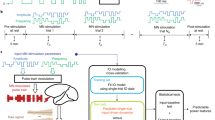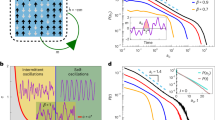Abstract
The problem of the stability and adaptability of regulatory processes is considered, taking as a point of departure N. P. Bekhtereva's theory regarding stable pathological states, and inflexible and adaptable links in control systems. The need to introduce a probabilistic approach is emphasized. Generalizations are made on materials relating to the connectability of the separate components of the biorhythms of functional systems, and to the stability of their amplitude-frequency characteristics. The corpus of facts permitted the successful development in clinical practice of functional biocontrol and feedback.
Similar content being viewed by others
Literature cited
I. P. Ashmarin. Riddles and Discoveries in the Biochemistry of Memory [in Russian], Leningrad State University, Leningrad (1975).
S. S. Bekshaev, N. N. Vasilevskii, N. B. Suvorov, V. B. Kutuev, and S. I. Soroko, “The combinatorial approach to the analysis of the reciprocal statistical dependence of electroencephalographic rhythms.” in: Adaptive Reactions of the Brain and Their Prognostication [in Russian], Leningrad (1978), pp. 117–123.
S. S. Bekshaev, “Individual-typological features of the statistical structure of the interaction of EEG rhythms in man and its dynamics in the process of adaptation to extreme environmental conditions,” Doctoral Dissertation, Scientific-Research Institute of Experimental Medicine, Academy of Medical Sciences of the USSR, Leningrad (1983).
N. P. Bekhtereva, Neurophysiological Aspects of Psychological Activity in Man, 2nd edn. [in Russian], Meditsina, Leningrad (1974).
N. P. Bekhtereva, The Healthy and Diseased Brain in Man [in Russian], Nauka, Leningrad (1980).
N. P. Bekhtereva, P. V. Bundzen, and Yu. L. Gogolitsyn, The Brain Codes of Psychologial Activity [in Russian], Nauka. Leningrad (1977).
P. V. Bundzen, “The influence of illumination in Antarctica on the state of autoregulatory functions of the human brain,” Fiziol. Zh. SSSR im. I. M. Sechenova,55, No. 8, 929–939 (1969).
P. V. Bundzen and B. M. Shishkin, “Neurocybernetic aspects of the study of optimal control in brain activity,” in: Studies in Applied Neurocybernetics [in Russian], Leningrad (1973), pp. 35–120.
N. N. Vasilevskii, “Theoretical and physiological bases of the guided experiment as a method of systemic analysis,” in: Questions in Cybernetics, Problems of Medical Cybernetics, No. 24 [in Russian], Moscow (1975), pp. 113–119.
N. N. Vasilevskii, “Differential adaptability of the human brain,” Fiziol. Cheloveka,1, No. 3, 469–481 (1975).
N. N. Vasilevskii, The Ecological Physiology of the Brain [in Russian], Meditsina, Leningrad (1979).
N. N. Vasilevskii, “The evolution of the brain and the reflection of time: its connection with continuous development in the ontogenesis of the neuronal systems of memory,” Zh. évol. Biokhim. Fiziol., 18, No. 3, 229–237 (1982).
N. N. Vasilevskii and T. P. Shlyafer, “Differentiated participation of midbrain structures in the regulation of the voices of chicks,” Zh. évol. Biokhim. Fiziol.,13, No. 2, 203–210 (1977).
N. N. Vasilevskii, S. I. Siroko, and M. M. Bogoslovskii, Psychophysiological Aspects of Human Adaptation in the Antarctic [in Russian], Meditsina, Leningrad (1978).
N. N. Vasilevskii, T. P. Shlyafer, Zh. G. Aleksandrova, “Interaction of brain structures regulating the vocal and respiratory systems,” Fiziol. Zh. SSSR im. I. M. Sechenova,77, No. 5, 725–731 (1981).
N. N. Vasilevskii, N. B. Suvorov, S. S. Bekshaev, G. V. Kukhmina, V. V. Ur'yash, L. N. Gondareva, and V. B. Zagustina, “Neurophysiological and systemic mechanisms of the adaptational reaction to extreme environmental factors,” in: Self-Regulation of Functions and States [in Russian], Leningrad (1982), pp. 6–20.
E. G. Vashchillo, A. M. Zingerman, M. A. Konstantinov, and D. N. Menitskii, “Research into the resonance characteristics of the cardiovascular system,” Fiziol. Cheloveka,9, No. 2, 257–265 (1983).
A. M. Vein, “Toward a correlation of the clinical and experimental neuroses,” Zh. Vyssh. Nervn. Deyat. im. I. P. Pavlova,31, No. 1, 196–201 (1981).
Yu. L. Gogolitsyn and Yu. Kropotov, Research into the Frequency of Neuronal Discharge in the Human Brain [in Russian], Nauka, Leningrad (1983).
J. Delgado, Brain and Consciousness [Russian translation], Mir, Moscow (1971).
A. M. Zingerman, V. D. Volkova, V. N. Menitskii, P. V. Bundzen, and B. M. Shishkin, “Typological features of adaptation which determine the effectiveness of work activity,” Fiziol. Zh. SSSR im. I. M. Sechenova,60, No. 10, 1481–1493 (1974).
A. M. Zingerman and B. M. Shishkin, “On the question of individual features of the selfregulation of physiological functions,” Fiziol. Cheloveka,3, No. 1, 124–135 (1977).
F. Krik, “Molecular biology in the year 2000,” Priroda, No. 7, 42–45 (1971).
é. A. Kostandov, “The neurophysiologic mechanisms of unconscious psychological phenomena,” Usp. Fiziol. Nauk,12, No. 4, 3–27 (1981).
P. G. Kostyuk, “Some problems relating to evolution in contemporary neurophysiology,” Zh. évol. Biokhim. Fiziol.,11, No. 1, 3–10 (1975).
D. N. Menitskii, “Self-regulatory mechanisms of the conditioned reflex and their models,” in: Problems in Neurocybernetics [in Russian], Nauka, Moscow (1974), Vol. 5, Part 2.
D. N. Menitskii, “An analysis of the informational and activational components of reinforcement in a conditioned reflex experiment,” Zh. Vyssh. Nervn. Deyat. im. I. P. Pavlova,33, No. 5, 803–812 (1983).
V. M. Smirnov and Yu. S. Borodkin, Artificial Stable Functional Connections [in Russian], Meditsina, Leningrad (1979).
S. I. Soroko, “The rearrangement of the structure of the EEG in the process of adaptation in the Antarctic,” Fiziol. Cheloveka,7, No. 5, 909–916 (1981).
S. I. Soroko, N. B. Suvorov, and S. S. Bekshaev, “Voluntary control of the level of bioelectrical activity of the human brain as a method of investigating the self-regulatory properties of the central nervous system,” in: The Adaptive Self-Regulation of Functions [in Russian], Meditsina, Moscow (1977), pp. 206–248.
S. I. Soroko and S. S. Bekshaev, “The statistical structure of the interrelationship of EEG rhythms and the individual properties of brain self-regulatory mechanisms,” Fiziol. Zh. SSSR im. I. M. Sechenova,67, No. 12, 1765–1773 (1981).
S. I. Soroko, Yu. A. Sidorov, V. B. Kutuev, V. V. Venikov, and A. A. Aldasheva, “The assessment and prognostication of the functional states of man in antarctic conditions,” in: The Self-Regulation of Functions and States [in Russian], Leningrad (1982), pp. 108–119.
N. B. Suvorov and N. N. Vasilevskii, “The features of cyclical interaction of brain structures in diverse conditions and forms of activity,” Fiziol. Zh. SSSR im. I. M. Sechenova,67, No. 7, 970–977 (1981).
T. P. Shlyafer, Zh. G. Aleksandrova, and N. N. Vasilevskii, “The reactions of the neurons of mid- and interstitial brain structures in the presence of the perception of acoustical signals and of elicited vocalization,” Fiziol. Zh. SSSR im. I. M. Sechenova,64, No. 2, 143–150 (1978).
F. Schmidt (ed.), Foreword to: The Rational Brain [Russian translation], Mir, Moscow (1981).
Author information
Authors and Affiliations
Additional information
Translated from Fiziologicheskii Zhurnal SSSR imeni I. M. Sechenova, Vol. 70, No. 7, pp. 961–967, July, 1984.
Rights and permissions
About this article
Cite this article
Vasilevskii, V.N. The systemic approach to the stability and plasticity of neurophysiological processes during adaptive brain activity. Neurosci Behav Physiol 16, 333–339 (1986). https://doi.org/10.1007/BF01148177
Received:
Issue Date:
DOI: https://doi.org/10.1007/BF01148177




